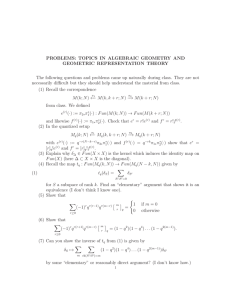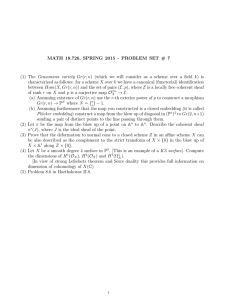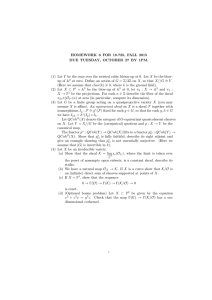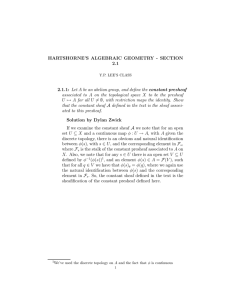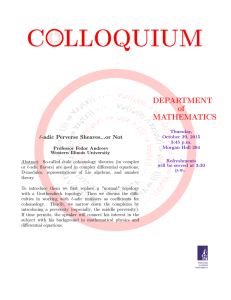l-adic cohomology
advertisement
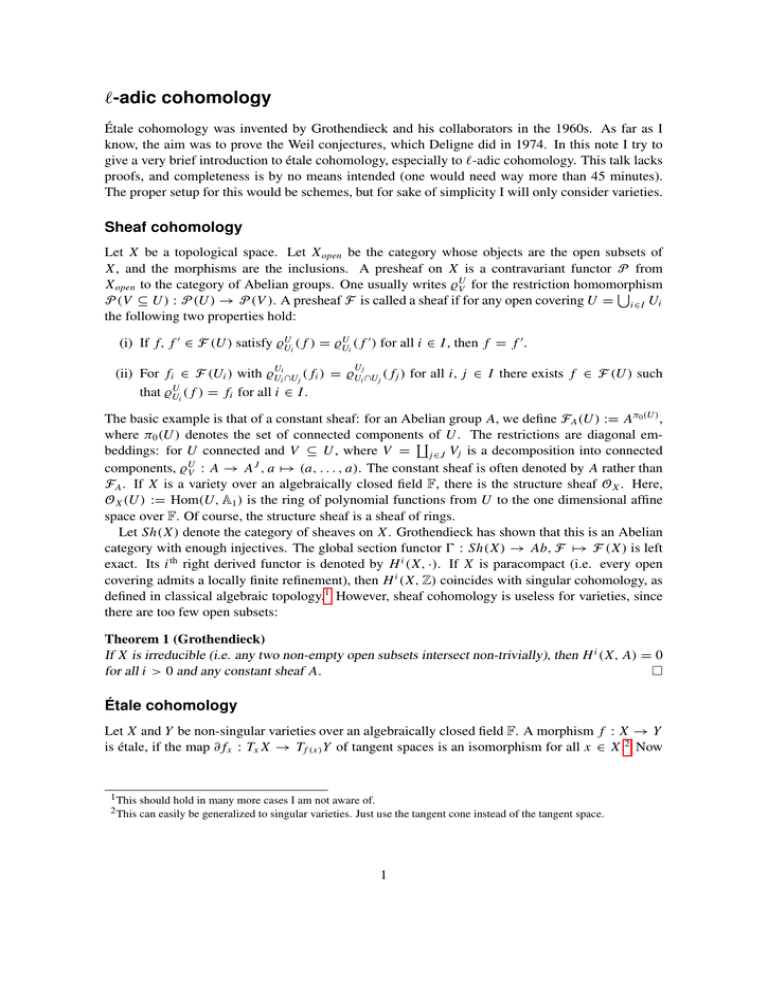
`-adic cohomology
Étale cohomology was invented by Grothendieck and his collaborators in the 1960s. As far as I
know, the aim was to prove the Weil conjectures, which Deligne did in 1974. In this note I try to
give a very brief introduction to étale cohomology, especially to `-adic cohomology. This talk lacks
proofs, and completeness is by no means intended (one would need way more than 45 minutes).
The proper setup for this would be schemes, but for sake of simplicity I will only consider varieties.
Sheaf cohomology
Let X be a topological space. Let X open be the category whose objects are the open subsets of
X , and the morphisms are the inclusions. A presheaf on X is a contravariant functor P from
X open to the category of Abelian groups. One usually writes %UV for the restriction homomorphism
S
P (V ⊆ U ) : P (U ) → P (V ). A presheaf F is called a sheaf if for any open covering U = i∈I Ui
the following two properties hold:
(i) If f, f 0 ∈ F (U ) satisfy %UUi ( f ) = %UUi ( f 0 ) for all i ∈ I , then f = f 0 .
U
(ii) For f i ∈ F (Ui ) with %UUii ∩U j ( f i ) = %Uij ∩U j ( f j ) for all i, j ∈ I there exists f ∈ F (U ) such
that %UUi ( f ) = f i for all i ∈ I .
The basic example is that of a constant sheaf: for an Abelian group A, we define F A (U ) := Aπ0 (U ) ,
where π0 (U ) denotes the set of connected components
`of U . The restrictions are diagonal embeddings: for U connected and V ⊆ U , where V = j∈J Vj is a decomposition into connected
components, %UV : A → A J , a 7→ (a, . . . , a). The constant sheaf is often denoted by A rather than
F A . If X is a variety over an algebraically closed field F, there is the structure sheaf O X . Here,
O X (U ) := Hom(U, A1 ) is the ring of polynomial functions from U to the one dimensional affine
space over F. Of course, the structure sheaf is a sheaf of rings.
Let Sh(X ) denote the category of sheaves on X . Grothendieck has shown that this is an Abelian
category with enough injectives. The global section functor 0 : Sh(X ) → Ab, F 7→ F (X ) is left
exact. Its i th right derived functor is denoted by H i (X, ·). If X is paracompact (i.e. every open
covering admits a locally finite refinement), then H i (X, Z) coincides with singular cohomology, as
defined in classical algebraic topology.1 However, sheaf cohomology is useless for varieties, since
there are too few open subsets:
Theorem 1 (Grothendieck)
If X is irreducible (i.e. any two non-empty open subsets intersect non-trivially), then H i (X, A) = 0
for all i > 0 and any constant sheaf A.
Étale cohomology
Let X and Y be non-singular varieties over an algebraically closed field F. A morphism f : X → Y
is étale, if the map ∂ f x : Tx X → T f (x) Y of tangent spaces is an isomorphism for all x ∈ X .2 Now
1 This should hold in many more cases I am not aware of.
2 This can easily be generalized to singular varieties. Just use the tangent cone instead of the tangent space.
1
let X et be the category whose objects are étale morphisms U → X , and whose morphisms are
commutative triangles:
/ U0
U@
@@
@@
@@
X
}
}}
}
}
}~ }
Obviously, embeddings of open subspaces are étale, so X open is a full subcategory of X et . As before,
a presheaf on X is a contravariant functor P : X et → Ab. To define what a sheaf is, we need a
generalization of the intersection of open subsets. The obivous choice is the pull-back or fibered
product:
/ U0
U ×X U 0
/X
U
It is easy to see that the corresponding map U × X U 0 → X is étale. Now define a presheaf F
to be a sheaf if the two conditions from classical sheaf theory are satisfied, where "open covering"
is replaced by "étale covering", and the intersection is replaced by the fibered product.
Here, an
S
étale covering of U → X is a set of étale maps f i : Ui → U such that U = i∈I f i (Ui ). The
basic example is again the constant sheaf F A for an Abelian group A. It is defined – again – to be
F A (U → X ) := Aπ0 (U ) . The classical structure sheaf can be extended to the étale structure sheaf
O X et , defined by O X et (U → X ) := OU (U ). Let Sh et (X ) be the category of étale sheaves on X . As
above, this is an Abelian category with enough injectives, and the global section functor
0 : Sh et (X ) → Ab, F 7→ F (X → X )
is left exact. The i th right derived functor H i (X, F ) of 0 is called i th étale cohomology group of X
with coefficients in F .
Let P be an étale presheaf on X . Then there exist aP ∈ Sh et (X ) and a morphism a : P → aP
such that every morphism P → F for a sheaf F factors uniquely through a. The sheaf aP is
called the sheafification of P . A sheaf is called a torsion sheaf if it is the sheafification of a presheaf
P , where each P (U → X ) is a torsion group.
Theorem 2
Let X be a variety over an algebraically closed field. Then H i (X, F ) = 0 for all torsion sheafs
F ∈ Sh et (X ) and all i > 2 dim(X ).
A variety X is called complete, if for each variety Y , the projection X × Y → Y is a closed map.
Étale cohomology behaves nicer if only complete varieties are considered. For example, there is the
following theorem:
Theorem 3
Let X be complete variety, and let A be a finite Abelian group. Then H i (X, A) is finite.3
3 This holds for all constructible sheaves, not just for constant ones. However, I did not want to introduce yet another
kind of sheaves.
2
Cohomology with compact support
Nagata has shown that for any variety X , there exists a complete variety X and an open immersion
j : X → X such that j (X ) is dense in X . By abuse of notation, X is called a compactification of X .
Now let F ∈ Sh et (X ). Let j! F ∈ Sh et (X ) be the sheafification of
(
0
α(U ) * j (X )
j! F (α : U → X ) :=
F (U ) α(U ) ⊆ j (X )
This procedure is called "extension by zero". If F is a torsion sheaf, Hci (X, F ) := Hci (X , j! F )
is called the i th cohomology group of X with compact support and coefficients in F . Although
compactifications are far from being unique, this can be shown not to depend on the chosen compactification. The disadvantage of cohomology with compact support is that it is not a derived
functor. However, it has a number of nice properties, e.g. it satisfies an open-closed exact sequence
and a Künneth formula. Also, the cohomology groups Hci (X, A) are finite for a finite Abelian group
A. However, to prove the Weil conjectures (and for applications in representation theory), it is
necessary to have cohomology with coefficients in characteristic zero.
`-adic cohomology
Let ` be a prime, Z` be the `-adic integers, and let Q` be the field of `-adic numbers. Also, let
F be an algebraically closed field of characteristic different from `, and let X be a variety over
F. Since Z` is equal to the inverse limit lim Z/`n Z, one defines H i (X, Z` ) := lim H i (X, Z/`n Z)
←
−
←
−
and H i (X, Q` ) := H i (X, Z` ) ⊗Z` Q` , and similarly for cohomology with compact support. Then
Hci (X, Z` ) is a finitely generated Z` -module, hence Hci (X, Q` ) is a finite-dimensional Q` -vector
space. It is often easier to work with cohomology with coefficients in Q` , since the torsion part of
Hci (X, Z` ) is difficult to handle.4
Let g ∈ Aut(X ) be an automorphism of finite order. This
an automorphism of Hci (X, Q` ),
Pinduces
2d
which will also be denoted by g. The sum L(g, X ) := i=0 (−1)i Tr(g, Hci (X, Q` )) is called the
Lefschetz number of g on X . Here, d := dim(X ), and Tr(g, V ) denotes the trace of the endomorphism g of V . The Lefschetz numbers were used by Deligne and Lusztig to construct virtual
characters of finite groups of Lie type. They can be defined without `-adic cohomology, as will be
shown now.
Theorem 4 (Grothendieck’s trace formula)
Suppose that F is the algebraic closure of the finite field Fq , and that X is defined over Fq with
corresponding Frobenius endomorphism F.5 Then
|X F | =
2 dim(X
X)
Tr(F, Hci (X, Q` )),
i=0
where X F := {x ∈ X | F(x) = x}.
4 See the paper "Catégories dérivées et variétés de Deligne-Lusztig" from Bonnafé and Rouquier, where they prove that
Jordan decomposition is a Morita equivalence. The main difficulty is to show that the relevant cohomology groups
are torsion-free.
5 The easiest example is the affine space, where F takes every component to the q th power.
3
Corollary 5
Let the assumptions be as above, and let g ∈ Aut(X
(i.e. g commutes with F)
P ) beg Fan rational
n
|t
.
Then
L(g, X ) = R(t)|t=∞ .
automorphism of finite order. Also, let R(t) := − ∞
|X
n=1
Proof: For 0 ≤ i ≤ 2d, where d := dim(X ), let αi j and βi j be the eigenvalues of g and F,
respectively, on Hci (X, Q` ) for 1 ≤ j ≤ dim Hci (X, Q` ). Since F and g commute, they can be
transformed into triangular form simultaneously. Also, g F n is a Frobenius endomorphism of X ,
hence Grothendieck’s trace formula yields
R(t) = −
∞ X
2d X
X
n=1 i=0
j
αi j βinj t n = −
X
i, j
αi j
∞
X
X
(βi j t)n = −
αi j
n=1
i, j
βi j t
.
1 − βi j t
Thus R(t) is a rational function, where numerator
and denominator have the same degree. Hence
P
1
one can define R(t)|t=∞ := R( t )|t=0 = i, j αi j = L(g, X ).
Corollary 6
The Lefschetz number L(g, X ) is an integer independent of `.
Proof: Lefschetz numbers are algebraic integers by definition. They are independent of ` and values
of rational functions with coefficients in Q by the above corollary.
4
